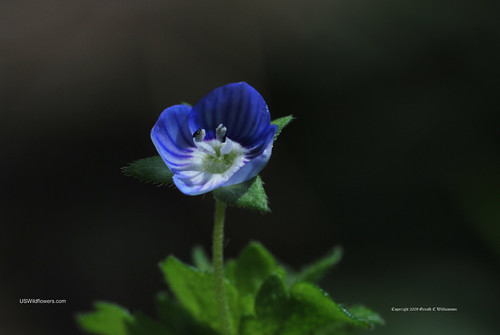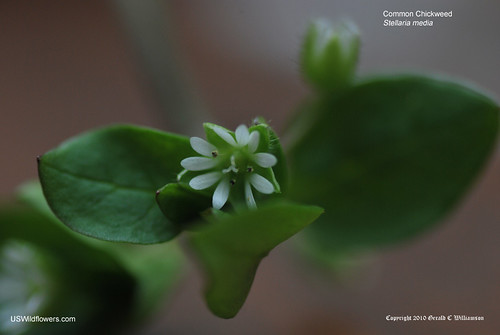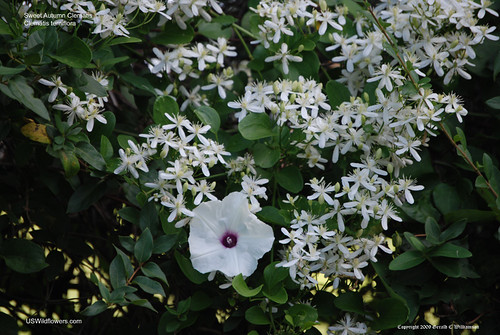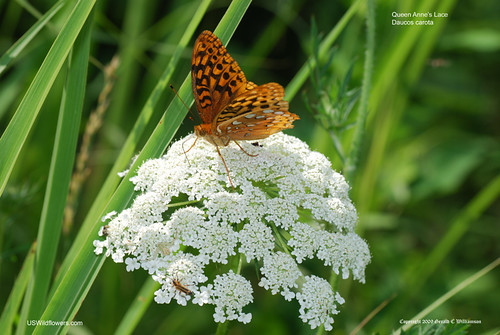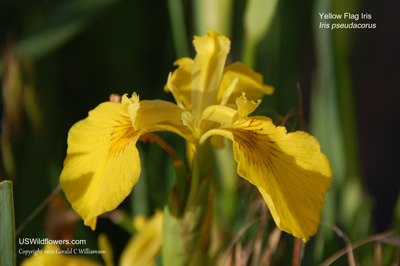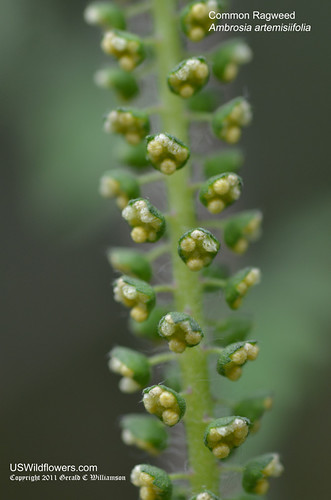Obedient Plant, a native species, has been added to the USWildflowers database (12/04/2012.) Scientific name is Physostegia virginiana. Photo below was taken along the Blue Ridge Parkway, Haywood County, NC, on Aug 1, 2011. Go to the Obedient Plant detail page for more photos and information.
Bird’s Eye Speedwell
USWildflowers Daily Plant 12/04/2012
Photo from 3/30/2009. Location: Walker County, GA
Bird’s Eye Speedwell, an introduced and possibly invasive species. For more information go to the Veronica persica detail page.
Common Chickweed
USWildflowers Daily Plant 12/03/2012
Photo from 2/21/2010. Location: Walker County, GA:
Common Chickweed, an introduced and possibly invasive species. For more information go to the Stellaria media detail page.
Sweet Autumn Clematis
USWildflowers Daily Plant 12/02/2012.
Photo from 8/23/2009. Location: Walker County, GA.
Sweet Autumn Clematis, an introduced species, are the smaller flowers shown here surrrounding a native Wild Potato Vine blossom. For more photos and information go to the Clematis terniflora detail page.
Queen Anne’s Lace
USWildflowers Daily Plant 12/01/2012
Photo from 6/6/2009. Location: The Pocket, Walker County, GA
Queen Anne’s Lace, an introduced and possibly invasive species. For more information go to the Daucus carota detail page.
Thanks to Allen Boynton for identifying the butterfly as a Great Spangled Fritillary.
Yellow Flag – Iris pseudacorus – Added to USWildflowers’ Database
Yellow Flag, an introduced and possibly invasive species, has been added to the USWildflowers database (11/27/2012.) Scientific name is Iris pseudacorus. It is also known by the common names Paleyellow Iris, Yellow Iris, and Water Flag. Photo below was taken along an irrigation canal in Boise, Ada County, ID, on June 8, 2010. Go to the Yellow Flag detail page for more photos and information.
Lula Lake Area and Lula Falls – 11/24/2012
On Friday, 11/23, I was planning for a potential visit to Virgin Falls in February and I ran across information that Virginia Spiraea – Spiraea virginiana – one of the rarest shrubs in North America, is found there. A bit more time on Google quickly revealed that Virginia Spiraea is also found along Rock Creek at Lula Lake, and I got pretty excited. Lula Lake is on Lookout Mountain just above the valley where I live south of Chattanooga. Found the Lula Lake Land Trust on Facebook, and lo and behold, there was a picture of a gentleman looking at their Virginia Spiraea posted only a couple of days earlier, and a notice that the property would be open today, Saturday. OK, there are now some tentative plans for Saturday.
#NPOD: Common Ragweed #Nativeplants
Native Plant of the Day 11/22/2012
Photo from 9/4/2011. Location: Walker County, GA
Common Ragweed – for more photos and information go to the Ambrosia artemisiifolia detail page.
Cankerweed – Prenanthes serpentaria – Added to USWildflowers’ Database
Cankerweed, a native species, has been added to the USWildflowers database (11/20/2012.) Scientific name is Prenanthes serpentaria. It is also known by the common names Lion’s Foot, Snakeweed, Earthgall, and Butterweed. Photo below was taken along the Blue Ridge Parkway, Haywood County, NC, on Aug 1, 2011. Go to the Cankerweed detail page for more photos and information.
Cedar Waxwing #birds in Bradford Pear Tree
Around 20 years ago when I planted a row of Bradford pear trees in front of my house, I thought I liked them. Now I’m thinking of replacing them, even though I still like them – occasionally. Those occasions are the 2 days in the spring while they bloom (OK, maybe it’s 3 days,) the week or so in the fall while they turn a beautiful red/purple/orange before dropping their leaves, and finally whenever the Cedar Waxwings show up to eat the berries. I still want to replace the trees, but it will have to be with something (native) that will continue to feed the Cedar Waxwings (wonder about Serviceberry.) This fall the arrival of these lovely birds coincided with the fall color of the leaves – reducing my time of appreciation for my Bradford pear trees. (Click on the photos for a larger view.)


